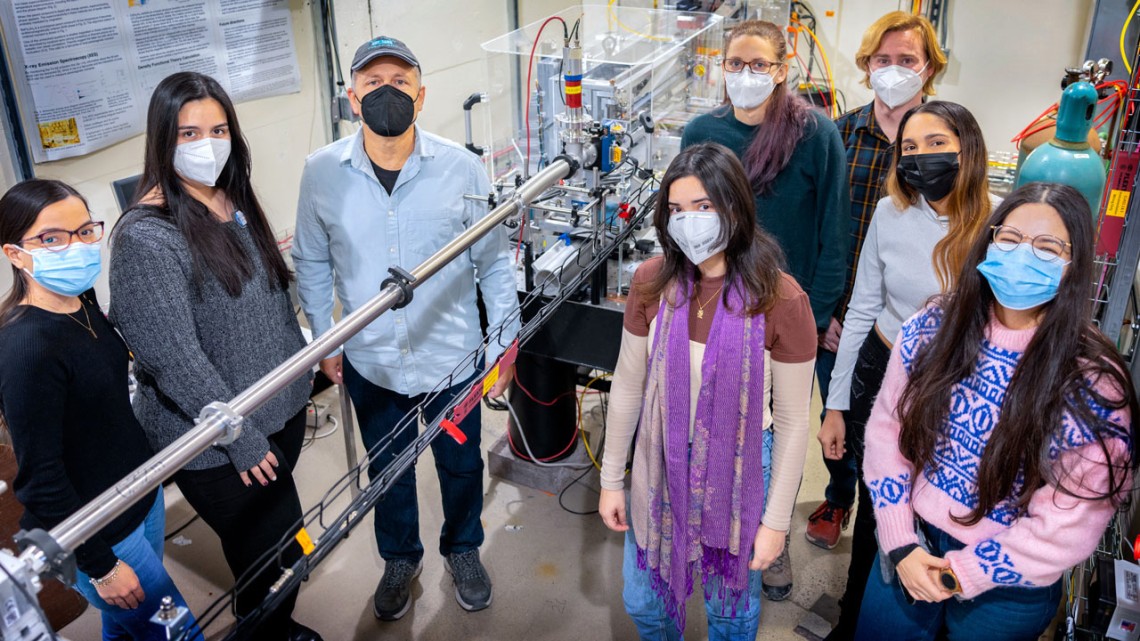
CHESS continues its legacy as a unique synchrotron light source located on a university campus. Students from the University of Puerto Rico will be partnering with CHESS staff on components of the HMF beamline.
CHESS celebrates 75 years of synchrotron light
By Susan Newman
In his dark basement lab in Wurzberg, Germany, in 1895, Wilhelm Röntgen produced the first-ever X-ray image using a cathode ray tube – a radiograph of his wife’s hand, wedding ring and all. Today, 60 feet below the Ithaca campus, at the Cornell High Energy Synchrotron Source (CHESS), researchers utilize X-rays that are 100 million times more intense than Röntgen's first beams of light.
Researchers at CHESS examine proteins that reveal new ways to fight cancer, battery cells that enable a charge far beyond current capabilities and structural materials that enable space travel to improve with lightweight, yet more structurally sound components. Today’s high energy X-rays provide scientific advances and innovation far beyond what Röntgen could have ever imagined.
The first observation of synchrotron radiation took place 75 years ago, on April 24, 1947 at General Electric in Schenectady, New York. Shortly after this initial discovery, researchers at Cornell characterized and verified synchrotron radiation with a 300MeV synchrotron in the basement of Newman Laboratory.
For many years, however, the radiation produced by synchrotrons was seen as a “hazard” that researchers had to shield against, and the radiation also meant losses in the energy of the synchrotron beam that had to be “topped off” constantly in order to keep the beams consistent. Furthermore, the X-rays weren’t deemed particularly useful, as researchers could much more easily (and cheaply) produce X-rays in their own labs by using the widely available rotating anode tubes.
Nevertheless, synchrotron research at Cornell has persisted and flourished for decades, also playing an integral role in advancing the utility of synchrotron radiation. Several synchrotrons were built in quick succession following the 300MeV machine – first at 1.4 GeV, then 2.2 GeV, and 10 GeV (eventually extended to 12 GeV). Construction of the 10 GeV synchrotron at Wilson Lab was completed in 1968 and is still currently operated today on Cornell’s campus.
As CHESS enters its 43rd year of operations, its scientific advancements and discoveries have grown continuously, thanks to its inherent connection to Cornell, and particularly the Cornell Laboratory for Accelerator-based ScienceS and Education, CLASSE.
Today, CHESS continues to build on its legacy of innovation, education, and discovery today. Ground was recently broken on a new experimental hall which will expand the synchrotron radiation facility. The new hall will contain one planned beamline and the potential for three additional beamlines in the future. The planned beamline, the High Magnetic Field (HMF) beamline, is a collaboration with the National Magnetic Field Lab and the University of Puerto Rico.
X-rays can uniquely address fundamental, long-standing questions about the nature of matter in high magnetic fields, and the new HMF facility will enable research that is currently not achievable anywhere else in the world.
The HMF project will not only create new opportunities for research, it will help to train the next generation of high energy X-ray scientists and technicians as well.
“This new beamline will be a generational change for both CHESS and the X-ray community,” said Joel Brock, director of CHESS. “While we have plenty of X-ray users at CHESS, the pipeline for beamline scientists – the people that know how to build an actual beamline – is drying up. This new project will not just expand the lab, it will also expand the network of experts of the underpinnings of the technology. That is why the education of undergraduates, grad students and postdocs is a major part of this project.”
Media Contact
Get Cornell news delivered right to your inbox.
Subscribe
